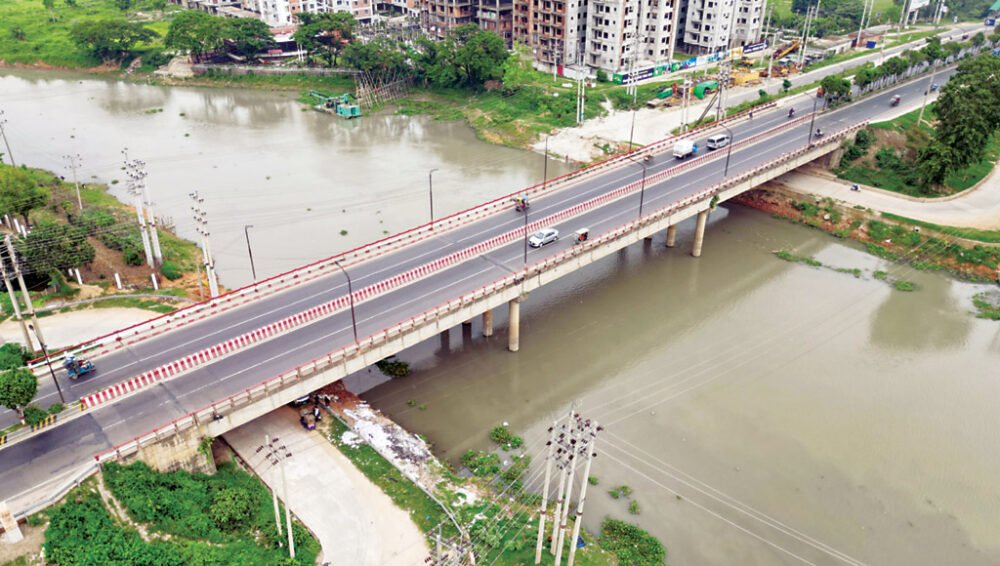Bangladesh News Desk: The Roads and Highways Department has earth-filled at least 20 rivers and canals crossing different highways across the country to construct U-loops.
Officials claimed that U-loops were developed using water bodies beneath bridges to facilitate seamless road communication.
Green activists, however, criticised the action, saying that it would further choke off the rivers already constricted by land grabbing, sedimentation, and pollution and decrease the navigability of the waterways.
The U-loops eat up at least 60 feet of the water bodies below the bridges, narrowing the water flow.
According to RHD statistics, at least 35 U-turns or U-loops have already been constructed, and four others are now under construction on the Dhaka-Aricha Highway and the Dhaka-Chattogram Highway.
RHD officials said that at least 20 of them were constructed below bridges because of the scarcity of land, while others were constructed by widening the highways vertically.
RHD filled the Turag River, Karnatoli, Karbapara Khal, and Bansi River on the Dhaka-Aricha Highway, while Marikhali, Gumti, and Sitalakhya rivers were among others filled to construct U-loops on the Dhaka-Chattogram Highway.
National River Conservation Commission chairman Sarwar Mahmud said that such activities stood against the verdict of the High Court and the directives of the Prime Minister, who asked to restore the rivers that had already lost flow.
‘As guardians of the rivers, we will take action,’ he said.
Bangladesh Environmental Lawyers Association chief executive Syeda Rizwana Hasan said that in the name of road network development, rivers and canals were killed in a planned way.
Construction of roads grabbing rivers is the latest example of such actions, she said.
She said that instead of dredging, a portion of the rivers were grabbed permanently for the U-loop.
She explained that below bridges, U-loops were constructed on riverbeds that would further reduce water flow.
‘RHD cannot construct such a structure by ignoring laws,’ she said.
River and Delta Research Centre chairman Mohammad Azaz said that it was a type of grabbing by a public agency.
Individuals and businesses will be inspired to grab rivers when public agencies themselves are doing it, he said.
Construction of roads on the bed of rivers without any water modelling would be the final nail in the coffin of rivers, Azaz added.
‘Water vessel movement will face further barriers due to the narrowing of the flow,’ he said.
Bangladesh Inland Water Transport Authority joint director Md Abdus Salam said that the RHD constructed the U-loops without clearance from the BIWTA.
‘Earth filling on riverbeds is not accepted. It will disrupt vessel movements on the waterways,’ he said, adding that the RHD did not inform them about it.
RHD’s acting chief engineer, Shoaib Ahmed, said that some U-loops were constructed under mega projects, while others were constructed without study to facilitate public movement.
He admitted that there might be some negative impacts from such a structure if nature were taken into account.
The construction of such structures on rivers is a violation of the Bangladesh Environment Conservation Act, 1995, the Water Act, 2013, and the Port Act, 1908, among others, while the High Court declared all rivers ‘living entities’ and gave them the legal rights to protect themselves in a 2023 verdict.
On December 4, 2023, prime minister Sheikh Hasina, in a meeting, ordered the authorities concerned to take the necessary initiatives to restore all canals in the capital Dhaka and its adjacent areas, as well as the Buriganga, Shitalakshya, Turag, and Balu rivers, in the quickest possible time.
Earlier, she directed the administration to take legal action against grabbers, no matter how influential the encroachers were.
Professor Mohammad Asad Hussain, director of the Institute of Water and Flood Management at the Bangladesh University of Engineering and Technology, said that without study, no structure should be allowed on any water body.
‘Narrowing rivers can create wider problems in the long run due to obstruction in water flow,’ he said, adding that this might aggravate the already acute water stagnation problems in cities like Dhaka and Chattogram.
Within less than one kilometre on the Dhaka-Aricha Highway, RHD constructed four U-loops on two rivers at Savar, on the outskirts of the capital.
Upon visiting a U-loop constructed by filling Karnapara Khal, it was found that the RDH built a service road that filled in the water body on both sides by 30 to 40 feet with municipal waste.
In June 2023, state minister for shipping Khalid Mahmud Chowdhury informed parliament that over 50,000 individuals were involved in illegal encroachments on rivers nationwide.
Inland waterways, once the prime mode of transportation in Bangladesh, have declined fast as many rivers, canals, and other water bodies have disappeared in riverine Bangladesh over the past decades.
BIWTA statistics showed that in 1975, there were 223 river routes and about 8,489 kilometres of navigable waterways in the rainy season in Bangladesh and 5,287 kilometres in the dry season.
At present, about 5,900 kilometres of waterways are navigable in the rainy season, and only about 3,800 kilometres of waterways are navigable in the dry season on 188 routes.
The LGED claims to have built 36,311 bridges to complete its 330,831-kilometre road network across the country, while the RHD claims to have built 4,404 bridges and 14,814 culverts in its 22,418km length of 992 roads.
Bridges and culverts disrupted waterways for narrow and short heights in many places, according to green activists.

